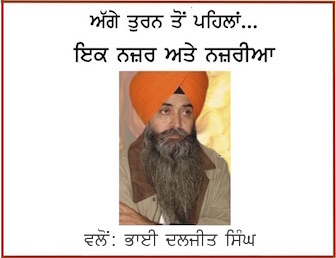General News
Recognize Bhindranwale as symbol of oppressed South Asian Minorities
May 5, 2013 | By Sikh Siyasat Bureau
Amritsar, Punjab (May 05, 2013): Sikh Information Centre (SIC) has issued the following policy statement in response to demands for removal of the reverend Sant Jarnail Singh Bhindranwale’s name from the Saka June 1984 memorial at the Darbar Sahib, Amritsar:
Jarnail Singh Bhindranwale’s name is inscribed on a brand-new memorial of the victims of Operation Bluestar. The memorial at the Golden Temple has angered the political establishment, who stirred up controversy by demanding censorship of Bhindranwale’s name. At the strong-arming of political party Shiromani Akali Dal, the temple committee recently bowed to political pressure by removing a photo of Bhindranwale displayed in another area of the temple.
The Sikh Information Centre calls on the Sikh people, the democratic citizens of India, and every defender of international human rights to oppose this act of censorship. The censorship of the contributions of Bhindranwale is as grievous a crime as would be censorship of the civil rights heroes who were killed at Tiananmen Square.
Jarnail Singh Bhindranwale was murdered in 1984 in an unprovoked attack by the Indian Army on peaceful citizens. In 21st century India, tyrants are made chief ministers. Leading citizens are arrested for protesting tyranny. Human rights activists are eliminated. Buddhists, Christians, Muslims, and Sikhs are slaughtered by the untold thousands. Killers are rewarded. Murderers are exonerated by the courts. Bhindranwale remains an enduring symbol of hope for millions of South Asian minorities who are presently being actively oppressed by the Indian State.
Bhindranwale’s leadership in the South Asian Civil Rights Movement began in the mid-1970s during the constitutionally permitted establishment of a dictatorship by Prime Minister Indira Gandhi. From 1975 to 1977, PM Gandhi suspended elections and launched a war against her political opponents. False imprisonment, framed charges, torture, and extralegal killing became standard operating procedures for Indian security forces throughout the entire subcontinent during the Emergency. Police acted without any restraint of any kind. Forced sterilizations were performed on thousands of people from low-castes and other minority groups determined by the ruling power to be “undesirable stock.”
The only sustained and peaceful voice of resistance came from the Sikh people. By 1977, 140,000 protesters against the Emergency had been imprisoned without charges or trial; of these, 60,000 were Sikhs, though they constitute barely two percent of India’s population. The headquarters of this protest movement was the Golden Temple in the holy city of Amritsar in Punjab.
One of the leading voices of protest was Kartar Singh, the senior preacher of Sikh seminar Damdami Taksal. Kartar Singh, who mentored Bhindranwale as his successor, is particularly remembered for publicly rebuking PM Gandhi’s “throne of Delhi” during her appearance at the 300th anniversary of the assassination of Guru Tegh Bahadur by the dictatorial Mughal regime. Upon his death, Kartar Singh’s mantle was assumed by Bhindranwale.
After lifting the Emergency and a brief absence from office, PM Gandhi resumed active oppression of her political opponents in 1980. This time her greatest opposition was from the Sikh people in Punjab. Bhindranwale was now the most vocal voice. He traveled the countryside, preaching a faith of individual responsibility, hard work, equal rights, and a peaceful lifestyle. Simultaneously, he organized democratic action to protest tyrannical treatment by the central government. An example of this treatment is the Gandhi regime’s 1980 dismissal of Punjab’s democratically elected state government and imposition of direct dictatorial rule from New Delhi using a constitutional measure called President’s Rule.
In April 1982, the oppression of dissent by minorities escalated when the Gandhi regime employed infiltration and subterfuge to provoke communal conflict and destabilize Punjab. Clandestine agents of the Gandhi regime (as later divulged by an agent involved) planted severed cow heads at two Hindu temples in Amritsar, sparking the first Hindu-Sikh riots in recorded history. A note left at the staged crime claimed Sikh responsibility — an inexplicable claim, considering Sikhs, especially devout religious Sikhs such as Bhindranwale, are vegetarians who have historically opposed cow slaughter. The issue is highly sensitive in India, where cows are often legally protected and widely worshipped by the Hindu population.
Indian State oppression spread like wildfire in Summer 1982. In just under three months, 30,000 peaceful Sikh protesters were indefinitely detained. The movement was led by a joint coalition of Sikh preacher Jarnail Singh Bhindranwale and the Sikh political party Shiromani Akali Dal.
Operation Bluestar was carried out in 1984 to silence Bhindranwale, whom PM Gandhi seems to have believed had gained too powerful of an influence in Punjab. The military siege was launched at the height of the 378th anniversary of the assassination of Guru Arjan Dev (also by the Mughal regime), a summer festival during which hundreds of thousands visit the Golden Temple. The Indian Army surrounded the temple complex with 15,000 troops armed with heavy artillery, tanks, and helicopters. Bhindranwale, who was at the temple, was accompanied by a congregation of only a few hundred. Without provocation, the army fired the first shot on June 3. Simultaneous assaults on smaller Sikh temples throughout India also occurred. When hostilities ceased on June 6, approximately 10,000 Sikhs had been killed and 30,000 made homeless. Among the dead was Bhindranwale.
Finally, in October 1984, PM Gandhi was assassinated by her Sikh bodyguards for violating the Golden Temple with bloodshed. Subsequently, a three-day genocide of Sikhs was orchestrated in New Delhi by Congress Party Parliament Members, who distributed weapons, awarded cash bounties, and directed mobs to indiscriminately murder Sikhs and burn temples. Independent estimates of the dead range from 15,000 to 30,000. It was this action which inspired an 11-year insurgency and motivated mass Punjabi migration to the United States and other western nations.
The insurgency died out in 1995 after Indian police murdered human rights activist Jaswant Singh Khalra, whose work exposing the secret genocide of 25,000 unarmed Sikhs had just gained international prominence. Khalra was abducted from his family home in September 1995, imprisoned and tortured for two months, then killed and dumped in a canal by police.
Oppression extended far beyond the borders of the State of Punjab. Most major regions in India were affected by some similar form of social unrest provoked by tyrannical treatment from the Indian State. Among these was Kashmir, where in March 1996 another peaceful human rights activist named Jalil Andrabi was murdered by Indian Police and dumped in the Jhelum River. He had just exposed the genocide of Muslims in Kashmir, reporting:
“More than 40,000 people have been killed, which include all — old, men and children, women, sick and infirm. The youth of Kashmir have been mowed down. They are tortured in torture cells and… thousands of youth have been killed in police custody. These atrocities being committed on the people of Kashmir are not mere aberrations. These are part of deliberate and systematic state policy… aimed to silence the people of Kashmir into subjugation.”
Nothing has changed. South Asian minorities from every region of the subcontinent remain targets of intentional persecution by Indian State security forces. The Indian State remains the greatest threat to the liberty, peace, and prosperity of the individual South Asian.
This is confirmed in the U.S. State Department’s 2012 “Human Rights Practices Report” on India, which states:
“The most significant human rights problems were police and security force abuses, including extrajudicial killings, torture, and rape; widespread corruption at all levels of government, leading to denial of justice; and separatist, insurgent, and societal violence.
“Other human rights problems included disappearances, poor prison conditions that were frequently life-threatening, arbitrary arrest and detention, and lengthy pretrial detention. The judiciary was overburdened, and court backlogs led to lengthy delays or the denial of justice. Authorities continued to infringe on citizens’ privacy rights. The law in some states restricted religious conversion, and there were reports of arrests, but no reports of convictions under these laws. There were some limits on freedom of movement….
“Widespread impunity at all levels of government remained a serious problem. Investigations into individual cases and legal punishment for perpetrators occurred, but in many cases a lack of accountability due to weak law enforcement, a lack of trained police, and the overburdened and underresourced court system created an atmosphere of impunity.”
In 2013, the Indian State employs two primary forms of oppression:
First, is the legislative means of draconian laws restricting natural human liberties such as the freedoms of speech, religion, the press, assembly, privacy, and the rights to a speedy trial and habeas corpus. The Constitution of India is constructed is such a manner that it appalling permits most of these legislative means of tyranny to be conducted entirely within India’s law.
Second, is the fiat means of brutal assaults on peaceful demonstrations, arbitrary arrest of impartial citizens, warrantless imprisonment of voices of dissent, banning of books, universal application of torture to detainees from every walk of life, rape of both male and female detainees, assassination of human rights activists, infiltration of peaceful and democratic political movements, and outright war. Operation Bluestar, conducted by the Indian Army from June 3-6, 1984, is the most startling example of how the Indian State employs the fiat means of war to unabashedly oppress South Asian minorities.
Oppression is further encouraged by financial and other incentives for state agents and elected officials who most enthusiastically employ tyrannical measures. For instance, Congress Party MPs who led November 1984 genocide, such as Kamal Nath, Sajjan Kumar, and Jagdish Tytler, never faced charges, were all promoted to Cabinet positions, and now enjoy broad influence over national policy. After receiving over 41,000 cash bounties from the Indian State for killing Sikhs, high-ranking police officers like Sumedh Saini and Mohammad Izhar Alam were rewarded. Alam was nominated for political office in Punjab in 2011. Sumedh Saini was appointed Director of Indian police in Punjab in 2012.
An identical pattern occurs in instances of oppression of other minorities. Kashmir has already been discussed. In 2000 in the State of Gujarat, Chief Minister Narendra Modi orchestrated a genocide of Muslims. Nearly 2,000 Muslims were massacred by Hindu mobs who were assisted by police under direct orders from Modi. He was reelected with a landslide later that year and still rules Gujarat. Other examples include the massacre of Muslims after the destruction of the Babri Mosque in Uttar Pradesh which was led by L. K. Advani, who later become Deputy Prime Minster of India and the slaughter of Christians in Odisha, which was encouraged and assisted by Indian police.
Bhindranwale was one of the few courageous enough to stand up against the social institutionalization of tyranny that has crippled India for centuries. He symbolizes all those who have perished under the successive dictatorships of the Mughals, the British, and the Indian State. His example inspires the millions who languish under the devastating effects of the state-backed caste system to hope for deliverance. Bhindranwale represents a movement that has no borders because he stands for enslaved and oppressed peoples.
The Sikh Information Centre commends the life and legacy of the reverend Jarnail Singh Bhindranwale, asserts the sovereignty of the Akal Takht and the Golden Temple, which are collectively called the Harmandir Sahib complex, and demands international recognition of the Harmandir Sahib complex as possessing sovereignty in kind to the Vatican. Thus, SIC opposes the imposition of the will of any state or other political body on this religious institution.
Furthermore, SIC calls for equal and universal restoration of liberty to all Indian citizens, the uninterrupted preservation of their natural human rights, and justice for the victims and perpetrators of state-sponsored genocidal actions.
Watch Video:
To Get Sikh Siyasat News Alerts via WhatsApp:
(1) Save Our WhatsApp Number 0091-855-606-7689 to your phone contacts; and
(2) Send us Your Name via WhatsApp. Click Here to Send WhatsApp Message Now.
Sikh Siyasat is on Telegram Now. Subscribe to our Telegram Channel
Related Topics: Sant Jarnail Singh Bhindranwale, Sikh Information Centre (SIC)




